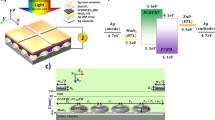Abstract
Nano-porous ultrathin plasmonic insulator-metal-insulator-metal (IMIM) solar cell with high power conversion efficiency up to 7% in broad wavelength range from 300 to 750 nm was theoretically studied. The proposed IMIM design allows to choose various bottom insulators with desired barrier height of metal-insulator interface due to independence of the total absorbance on the bottom insulator. IMIM structure shows 73.8% difference in the average absorbance between the top and bottom metal layers with 1-nm bottom insulator. Moreover, the incident light decreases the absorbance negligibly up to 35 degrees for both TE and TM modes and by 17.5% at 70 degrees. Furthermore, the absorption between TE and TM modes differs by less than 5%, which indicates the structure as polarization independent. Our results indicate IMIM design benefit in plasmonic solar cells demanding low thickness, flexibility, low-cost, and polarization independence. Moreover, this structure can be implemented for integrated optical circuits as well as for solar thermoelectric generator.



Similar content being viewed by others
References
Liang Q, Yu W, Zhao W, Wang T, Zhao J, Zhang H, Tao S (2013) Numerical study of the meta-nanopyramid array as efficient solar energy absorber. Opt. Mater. Express 3(8):1187–1196. doi:10.1364/OME.3.001187
Lobet M, Lard M, Sarrazin M, Deparis O, Henrard L (2014) Plasmon hybridization in pyramidal metamaterials: a route towards ultra-broadband absorption. Opt. Express 22(10):12678–12690. doi:10.1364/OE.22.012678
Hedayati M, Faupel F, Elbahri M (2012) Tunable broadband plasmonic perfect absorber at visible frequency. Appl. Phys. A 109(4):769–773. doi:10.1007/s00339-012-7344-1
Aydin K, Ferry VE, Briggs RM, Atwater HA (2011) Broadband polarization-independent resonant light absorption using ultrathin plasmonic super absorbers. Nat. Commun. 2(517):1–7. doi:10.1038/ncomms1528
Park H, Lee S-Y, Kim J, Lee B, Kim H (2015) Near-infrared coherent perfect absorption in plasmonic metal-insulator-metal waveguide. Opt. Express 23(19):24464–24474. doi:10.1364/OE.23.024464
Luo S, Li B, Xiong D, Zuo D, Wang X (2016) A high performance plasmonic sensor based on metal-insulator-metal waveguide coupled with a double-cavity structure. Plasmonics. doi:10.1007/s11468-016-0253-y
Chen Y, Dai J, Yan M, Qiu M (2014) Metal-insulator-metal plasmonic absorbers: influence of lattice. Opt. Express 22(25):30807–30814. doi:10.1364/OE.22.030807
Feng P, Li W-D, Zhang W (2015) Dispersion engineering of plasmonic nanocomposite for ultrathin broadband optical absorber. Opt. Express 23(3):2328–2338. doi:10.1364/OE.23.002328
Yan Z, Du W, Tu L, Gu P, Huang Z, Zhan P, Liu F, Wang Z (2015) A facile high performance SERS substrate based on broadband nearperfect optical absorption. J. Raman Spectrosc. 46(9):795–801. doi:10.1002/jrs.4721
Mann SA, Garnett EC (2015) Resonant nanophotonic spectrum splitting for ultrathin multijunction solar cells. ACS Photonics 2(7):816–821. doi:10.1021/acsphotonics.5b00260
Hao J, Wang J, Liu X, Padilla WJ, Zhou L, Qiu M (2010) High performance optical absorber based on a plasmonic metamaterial. Appl. Phys. Lett. 96(25):251104. doi:10.1063/1.3442904
Lei J, Ji B, Li J (2016) High-performance tunable plasmonic absorber based on the metal-insulator-metal grating nanostructure. Plasmonics. doi:10.1007/s11468-016-0242-1
Gundlach K (1973) Theory of metal-insulator-metal tunneling for a simple two-band model. J. Appl. Phys. 44(11):5005–5010. doi:10.1063/1.1662078
Mubeen S, Lee J, Lee W-R, Singh N, Stucky GD, Moskovits M (2014) On the plasmonic photovoltaic. ACS Nano 8(6):6066–6073. doi:10.1021/nn501379r
Chalabi H, Schoen D, Brongersma ML (2014) Hot-electron photodetection with a plasmonic nanostripe antenna. Nano Lett. 14(3):1374–1380. doi:10.1021/nl4044373
Wang F, Melosh NA (2013) Power-independent wave-length determination by hot carrier collection in metal-insulator-metal devices. Nat. Commun. 4:1711. doi:10.1038/ncomms2728
Gong T, Munday JN (2014) Angle-independent hot carrier generation and collection using transparent conducting oxides. Nano Lett. 15(1):147–152. doi:10.1021/nl503246h
Wang F, Melosh NA (2011) Plasmonic energy collection through hot carrier extraction. Nano Lett. 11(12):5426–5430. doi:10.1021/nl203196z
Hubarevich A, Kukhta A, Demir HV, Sun X, Wang H (2015) Ultra-thin broadband nanostructured insulator-metal-insulator-metal plasmonic light absorber. Opt. Express 23(8):9753–9761. doi:10.1364/OE.23.009753
Lumerical FDTD Software. Available from: https://www.lumerical.com/tcad-products/fdtd/. Accessed 3 Dec 2016
Pepper SV (1970) Optical analysis of photoemission. JOSA 60(6):805–812. doi:10.1364/JOSA.60.000805
Kanter H (1970) Slow-electron mean free paths in aluminum, silver, and gold. Phys. Rev. B 1(2):522–537. doi:10.1103/Phys Rev B.1.522
Ding ZJ, Shimizu R (1996) A Monte Carlo modeling of electron interaction with solids including cascade secondary electron production. Scanning 18(2):92–113. doi:10.1002/sca.1996.4950180204
Ashley J (1990) Energy loss rate and inelastic mean free path of low-energy electrons and positrons in condensed matter. J. Electron. Spectrosc. Relat. Phenom. 50(2):323–334. doi:10.1016/0368-2048(90)87075-Y
Robertson J, Chen C (1999) Schottky barrier heights of tantalum oxide, barium strontium titanate, lead titanate, and strontium bismuth tantalate. Appl. Phys. Lett. 74(8):1168–1170. doi:10.1063/1.123476
Kovacs D, Winter J, Meyer S, Wucher A, Diesing D (2007) Photo and particle induced transport of excited carriers in thin film tunnel junctions. Phys. Rev. B 76(23):235408. doi:10.1103/PhysRevB.76.235408
Gogoi N, Sahu PP (2015) All-optical compact surface plasmonic two-mode interference device for optical logic gate operation. Appl. Opt. 54(5):1051–1057. doi:10.1364/AO.54.001051
Gogoi N, Sahu PP (2016) All-optical surface plasmonic universal logic gate devices. Plasmonics 11:1537. doi:10.1007/s11468-016-0207-4
Sahu PP (2016) Theoretical investigation of all optical switch based on compact surface plasmonic two mode interference coupler. IEEE J. Lightwave Technol. 34(4):1300–1305. doi:10.1109/JLT.2015.2501317
Acknowledgements
A financial support was received from the National Research Foundation of Singapore (NRF7-CRP6-2010-2 and NRF-CRP12-2013-04).
Author information
Authors and Affiliations
Corresponding author
Rights and permissions
About this article
Cite this article
Hubarevich, A., Marus, M., Fan, W. et al. Highly Efficient Ultrathin Plasmonic Insulator-Metal-Insulator-Metal Solar Cell. Plasmonics 13, 141–145 (2018). https://doi.org/10.1007/s11468-016-0493-x
Received:
Accepted:
Published:
Issue Date:
DOI: https://doi.org/10.1007/s11468-016-0493-x




